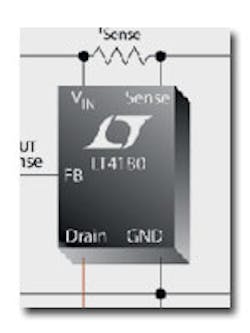Virtual Remote Sensing
Linear Technology CTO Bob Dobkin has been inventing again, and he’s come up with another of those “why didn’t somebody think of that decades ago?” ideas that has now been embodied in a chip. This time it’s about “remotely sensing” the voltage at a load that’s far away from the regulated supply that powers it. (What’s actually happening is that the cable resistance is being measured and compensated for during the regulation process.)
The load may be anything such as a security camera at the end of hundreds of feet of CAT5 cable, a battery being charged, or a laptop at the end of the cable from its ac-adapter supply. One simple example Dobkin likes to cite is tungsten-halogen lighting, where light output varies with the cube of the applied voltage.
“If you’re operating the bulb just 5% below its rated voltage, you’re losing 15% of the potential light output,” Dobkin says. He also notes that this often leads to expensive over-design. A more exotic class of applications would be remote instrumentation, as in oil-well logging.
Designers normally handle remote sensing and regulation today by measuring the drop across a sense resistor at the load. That’s simple and straightforward, Dobkin agrees, but the additional pair of wires this approach makes necessary may not be practical to implement or reliable in use. This also adds cost, and it simply may not be practical to add the additional wires.
“Add a mechanical connector to the wires,” Dobkin says, “and you’ve added unpredictable series resistances in both the supply and sense lines that can vary erratically over time.”
Therefore, Dobkin reasoned, what if you got rid of the sense resistor, but put a capacitance right across the load—not for measurement purposes, but simply to represent essentially zero impedance at high enough ac frequencies? That would allow you to periodically modulate the power supply’s output current at some dither frequency that would encounter an ac short at the end of the power-supply cable.
Measuring the ac drop at the power supply would tell you the impedance of the length of connecting cable, and that in turn would provide feedback for voltage regulation at the far end of the line at reasonable but not necessarily blindingly fast time constants. That is, you wouldn’t want to do this for really large or really fast load transients—Dobkin isn’t thinking about powering FPGAs. But for a reasonably large number of applications, this technique, which Linear calls Virtual Remote Sensing (VRS) (see the figure), is practical.
In Linear’s first product to embody VRS, the LT4180 forces a square-wave current with a peak-to-peak amplitude of ±5% relative to the nominal value onto the regulator’s output current. The far-end decoupling capacitor filters out the dither current from the VRS square wave at the load. With essentially an “ac short” at the square-wave frequency at the load end of the line, the LT4180 sees and measures a voltage waveform with a peak-to-peak amplitude equal to one-tenth of the line impedance. The result is fed back to the power supply to achieve regulation.
One of the beauties of the technique is that it doesn’t matter what kind of regulator is powering the load. The LT4180 works with any power supply or regulator—switching or linear, isolated or non-isolated. Specifically, the LT4180 can operate over an input voltage ranging from 3 to 50 V and can produce an output voltage from 1.21 to 50 V. It incorporates a 5-mA sink output that is powerful enough to drive an opto-coupler. Additional features include a programmable fixed dither frequency or spread-spectrum frequency, along with soft-start.
Three temperature grades are available: an extended grade version from –40°C to 85°C, an industrial grade version from –40°C to 125°C, and a military grade option from –55°C to 125°C. The 1000-piece price starts at $2.95 each. The LT4180 is offered in an SSOP-24 package.
About the Author

Don Tuite
Don Tuite (retired) writes about Analog and Power issues for Electronic Design’s magazine and website. He has a BSEE and an M.S in Technical Communication, and has worked for companies in aerospace, broadcasting, test equipment, semiconductors, publishing, and media relations, focusing on developing insights that link technology, business, and communications. Don is also a ham radio operator (NR7X), private pilot, and motorcycle rider, and he’s not half bad on the 5-string banjo.
